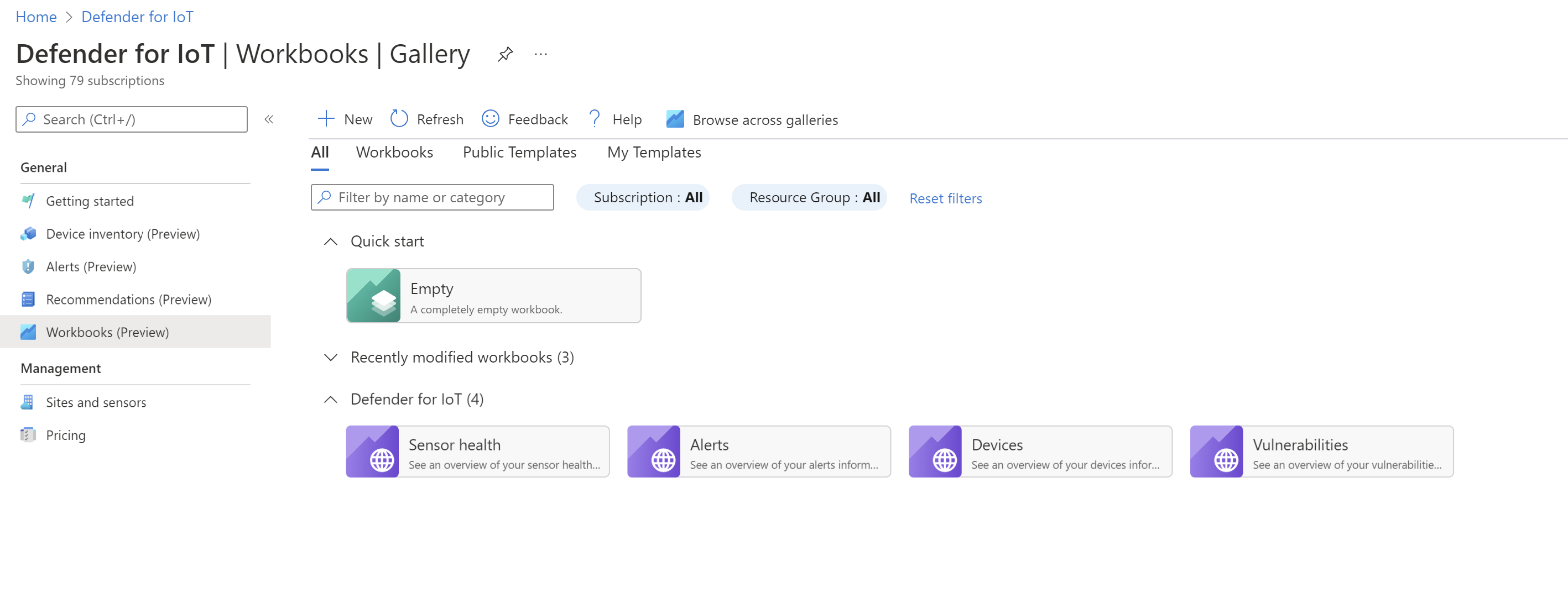使用 Azure 監視器活頁簿將適用於 IoT 的 Microsoft Defender 資料視覺化
Azure 監視器活頁簿提供圖形、圖表和儀表板,以視覺化方式反映儲存在 Azure Resource Graph 訂用帳戶中的資料,並可直接在適用於 IoT 的 Microsoft Defender 中使用。
在 Azure 入口網站中,使用適用於 IoT 的 Defender [活頁簿] 頁面來檢視 Microsoft 所建立並提供的現成可用活頁簿,或由客戶建立並跨社群共用的活頁簿。
每個活頁簿圖形或圖表都是以對資料執行的 Azure Resource Graph (ARG) 查詢為基礎。 在適用於 IoT 的 Defender 中,您可以使用 ARG 查詢來:
- 收集感應器狀態
- 識別網路中的新裝置
- 尋找與特定 IP 位址相關的警示
- 了解每個感應器看到哪些警示
檢視活頁簿
若要檢視 Microsoft 所建立的現成可用活頁簿,或其他已儲存至您的訂用帳戶的活頁簿:
適用於 IoT 的 Defender 提供下列現成可用活頁簿:
- 感應器健康情況。 顯示感應器健康情況的相關資料,例如感應器上安裝的感應器主控台軟體版本。
- 警示。 顯示感應器上發生的警示相關資料,包括依感應器的警示、警示類型、最近產生的警示等等。
- 裝置。 顯示裝置清查的相關資料,包括依廠商、子類型的裝置和發現的新裝置。
- 弱點。 顯示您網路上的 OT 裝置中偵測到之弱點的相關資料。 在 [裝置弱點]、[易受攻擊的裝置] 或 [易受攻擊的元件] 資料表中選取項目,以檢視右側資料表中的相關資訊。
建立自訂活頁簿
使用適用於 IoT 的 Defender [活頁簿] 頁面,直接在適用於 IoT 的 Defender 中建立自訂 Azure 監視器活頁簿。
在 [活頁簿] 頁面上,選取 [新增],或從其他範本開始,開啟範本活頁簿,然後選取 [編輯]。
在新的活頁簿中,選取 [新增],然後選取您要新增至活頁簿的選項。 如果您要編輯現有的活頁簿或範本,請選取右側的選項 (...) 按鈕,以存取 [新增] 功能表。
您可以將下列任何元素新增至活頁簿:
選項 描述 Text 新增文字來描述活頁簿上顯示的圖形,或所需的任何其他動作。 參數 定義要在活頁簿文字和查詢中使用的參數。 連結/索引標籤 將瀏覽元素新增至您的活頁簿,包括清單、其他目標的連結、額外的索引標籤或工具列。 查詢 新增建立您的活頁簿圖形和圖表時要使用的查詢。
- 請務必選取 Azure Resource Graph 作為資料來源,然後選取所有相關的訂用帳戶。
- 從 [視覺效果] 選項中選取類型,以新增資料的圖形表示。計量 新增建立活頁簿圖形和圖表時要使用的計量。 群組 新增群組以將您的活頁簿組織成子區域。 針對每個選項,定義所有可用的設定之後,選取 [新增...] 或 [執行...] 按鈕以建立該活頁簿元素。 例如,[新增參數] 或 [執行查詢]。
提示
您可以在 Azure Resource Graph Explorer 中建置查詢,並將其複製到活頁簿查詢中。
在工具列中,選取 [儲存]
 或 [另存新檔]
或 [另存新檔] 以儲存活頁簿,然後選取 [完成編輯]。
以儲存活頁簿,然後選取 [完成編輯]。選取 [活頁簿] 以返回包含完整活頁簿清單的主活頁簿頁面。
在查詢中參考參數
建立參數之後,請使用下列語法在查詢中參考參數:{ParameterName}。 例如:
iotsecurityresources
| where type == "microsoft.iotsecurity/sensors"
| extend Name=name
| extend Status= properties.sensorStatus
| where Name=={SensorName}
| project Name,Status
範例查詢
本節提供適用於 IoT 的 Defender 活頁簿中常用的範例查詢。
警示查詢
跨感應器散發警示
iotsecurityresources
| where type == "microsoft.iotsecurity/locations/devicegroups/alerts"
| extend Sensor=properties.extendedProperties.SensorId
| where properties.status!='Closed'
| summarize Alerts=count() by tostring(Sensor)
| sort by Alerts desc
過去 24 小時內的新警示
iotsecurityresources
| where type == "microsoft.iotsecurity/locations/devicegroups/alerts"
| where properties.status!='Closed'
| extend AlertTime=properties.startTimeUtc
| extend Type=properties.displayName
| where AlertTime > ago(1d)
| project AlertTime, Type
依來源 IP 位址的警示
iotsecurityresources
| where type == "microsoft.iotsecurity/locations/devicegroups/alerts"
| extend Type=properties.displayName
| extend Source_IP=properties.extendedProperties.SourceDeviceAddress
| extend Destination_IP=properties.extendedProperties.DestinationDeviceAddress
| where Source_IP=='192.168.10.1'
| project Source_IP, Destination_IP, Type
裝置查詢
依廠商的 OT 裝置清查
iotsecurityresources
| extend Vendor= properties.hardware.vendor
| where properties.deviceDataSource=='OtSensor'
| summarize Devices=count() by tostring(Vendor)
| sort by Devices
依子類型的 OT 裝置清查,例如,PLC、內嵌裝置、UPS 等等
iotsecurityresources
| where type == "microsoft.iotsecurity/locations/devicegroups/devices"
| extend SubType=properties.deviceSubTypeDisplayName
| summarize Devices=count() by tostring(SubType)
| sort by Devices
依感應器、網站和 IPv4 位址的新 OT 裝置
iotsecurityresources
| where type == "microsoft.iotsecurity/locations/devicegroups/devices"
| extend TimeFirstSeen=properties.firstSeen
| where TimeFirstSeen > ago(1d)
| extend DeviceName=properties.deviceName
| extend Site=properties.sensor.site
| extend Sensor=properties.sensor.name
| extend IPv4=properties.nics.[0].ipv4Address
| where properties.deviceDataSource=='OtSensor'
| project TimeFirstSeen, Site, Sensor, DeviceName, IPv4
依 Purdue 層級摘要警示
iotsecurityresources
| where type == "microsoft.iotsecurity/locations/devicegroups/alerts"
| project
resourceId = id,
affectedResource = tostring(properties.extendedProperties.DeviceResourceIds),
id = properties.systemAlertId
| join kind=leftouter (
iotsecurityresources | where type == "microsoft.iotsecurity/locations/devicegroups/devices"
| project
sensor = properties.sensor.name,
zone = properties.sensor.zone,
site = properties.sensor.site,
deviceProperties=properties,
affectedResource = tostring(id)
) on affectedResource
| project-away affectedResource1
| where deviceProperties.deviceDataSource == 'OtSensor'
| summarize Alerts=count() by tostring(deviceProperties.purdueLevel)
下一步
深入了解檢視關於感應器主控台的儀表板和報表:
深入了解 Azure 監視器活頁簿和 Azure Resource Graph:
意見反應
即將登場:在 2024 年,我們將逐步淘汰 GitHub 問題作為內容的意見反應機制,並將它取代為新的意見反應系統。 如需詳細資訊,請參閱:https://aka.ms/ContentUserFeedback。
提交並檢視相關的意見反應
